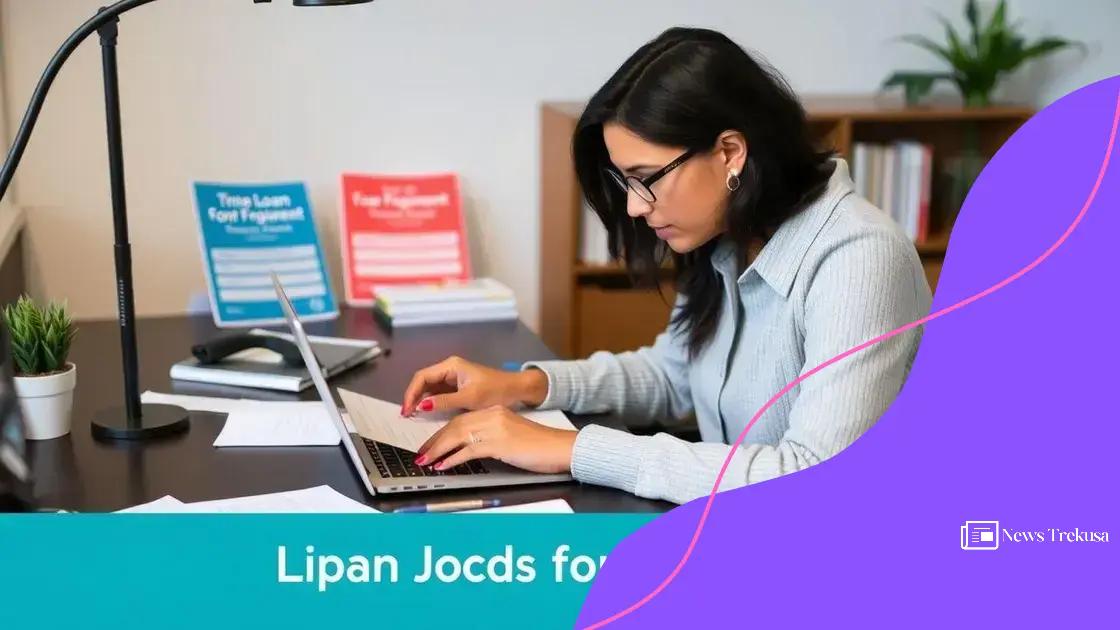Student loan forgiveness plans: what you need to know

Student loan forgiveness programs typically apply only to federal loans, require specific qualifications, and involve a set number of qualifying payments before you can receive forgiveness.
Student loan forgiveness plans are a lifeline for many, offering hope to those overwhelmed by debt. But do you really know how they work and who qualifies? Let’s dive into what these plans entail and how they might just save you financially.
Understanding student loan forgiveness options
Understanding student loan forgiveness options is crucial for anyone burdened by educational debt. There are various programs designed to help borrowers eliminate their loans, but knowing which one suits your situation is essential.
Types of Forgiveness Programs
Several programs are available, each with its own eligibility criteria. Here are some of the main ones:
- Public Service Loan Forgiveness: This program is aimed at those working in the public sector. After making 120 qualifying payments, you may have the remainder of your loans forgiven.
- Teacher Loan Forgiveness: If you teach for five consecutive years in a low-income school, you may qualify for forgiveness of up to $17,500.
- Income-Driven Repayment Forgiveness: Depending on your repayment plan, you could have remaining loan balances forgiven after 20 to 25 years of qualifying payments based on your income.
Each program has its unique set of requirements, and understanding these is the first step toward potential savings. For example, if you plan to enter a career in public service, aiming for Public Service Loan Forgiveness can be beneficial.
Checking Eligibility
Before applying for any forgiveness program, it’s vital to determine your eligibility. Factors to consider include:
- Your employment situation
- The type of loans you have
- How long you’ve been making payments
Gathering this information will help you navigate the options better. Additionally, try to keep track of your payment history, as this may come in handy during your application process.
In conclusion, knowing your options for student loan forgiveness can ease your financial burden significantly. By exploring these programs and understanding the eligibility requirements, you can take actionable steps toward a debt-free future.
Eligibility criteria for forgiveness programs
When considering eligibility criteria for forgiveness programs, it’s important to understand the factors that determine if you can qualify. Various programs require specific conditions to be met, and these may differ significantly.
Common Eligibility Requirements
Most forgiveness programs have a set of standard requirements. Here are some of the critical points to keep in mind:
- Loan Type: Not all loans qualify for forgiveness. Generally, federal loans have a higher chance of being forgiven than private loans.
- Employment Verification: Many forgiveness options, like Public Service Loan Forgiveness, require working for a qualified employer, usually in the public sector.
- Payment History: Making a certain number of qualifying payments is necessary. This often involves being in an approved repayment plan.
- Tenure: Some programs require you to serve in your position for a set duration, such as five years for teacher forgiveness.
Understanding these requirements is the first step toward taking full advantage of the programs available. It’s also essential to keep detailed records of your employment and loan payments to facilitate the application process.
Specific Program Criteria
Each forgiveness program may have unique criteria, depending on its goals. For instance, the criteria for Income-Driven Repayment Forgiveness differ from those of Public Service Loan Forgiveness.
Many borrowers often overlook minor details in their applications, which can lead to denial. Thus, it’s critical to thoroughly read the eligibility requirements for each program.
In addition, if you’re unsure about your eligibility status, contacting your loan servicer can provide clarity. They can help review your situation and direct you toward potential relief options.
How to apply for loan forgiveness

Applying for loan forgiveness can feel overwhelming, but breaking it down into steps makes it manageable. Knowing how to correctly apply can help you navigate the process smoothly.
Gather Necessary Information
The first step in your application is to collect all relevant documents and information. This includes:
- Loan Details: Have information about your loans ready, including the loan type and balance.
- Employment Verification: Be prepared to provide documentation that proves your employment if required by the forgiveness program.
- Payment History: Keep track of your payment records, showing when and how much you have paid.
Organizing these details beforehand can save you time and reduce stress in the long run.
Submitting Your Application
Once you have your information ready, you can proceed with the application. Here’s how you should approach this step:
- Complete the Application Form: Most forgiveness programs will require you to fill out a specific application form, which can usually be found on the program’s official website.
- Double-Check Your Information: Mistakes in your application can lead to delays, so take your time to ensure everything is accurate.
- Submit on Time: Be aware of deadlines. Timely submission is crucial to avoid missing your chance.
Once submitted, monitoring your application status is advisable. Keeping in contact with your loan servicer can help you stay updated.
Understanding the process of applying for loan forgiveness empowers you to take actionable steps toward financial relief. By following these guidelines, you set yourself up for success in the forgiveness journey.
Impact of forgiveness on credit scores
The impact of forgiveness on credit scores is a topic that concerns many borrowers. Understanding how loan forgiveness affects your credit can help you make informed decisions.
Understanding Credit Scores
Credit scores are numerical representations of your creditworthiness. Factors like payment history, credit utilization, and length of credit history contribute to your overall score. It’s crucial to understand how these factors interact, especially when considering loan forgiveness.
Effects of Forgiveness on Credit Scores
When loans are forgiven, your credit score may experience several changes. Here are some points to note:
- Reduction in Debt Load: Forgiveness decreases your overall debt, which could improve your credit utilization ratio, subsequently boosting your score.
- Payment History: If your loan is forgiven after you’ve made regular payments, those positive payment history records may remain on your credit report.
- Potential Negative Impact: In some cases, if loans are forgiven without prior payment or if loans in default are forgiven, this may reflect poorly on your credit history.
Monitoring your credit score regularly can help you understand how these changes affect you. It’s also wise to check for any errors on your report that may arise from the forgiveness process.
Next Steps After Forgiveness
After your loans are forgiven, consider how you can further improve your credit score. Here are a few strategies:
- Maintain Timely Payments: Continue to pay any other debts on time.
- Limit New Credit Inquiries: Avoid applying for too much new credit at once, as this can harm your score.
- Build Credit Responsibly: Consider small credit accounts that you can manage easily to build a positive history.
Being proactive about your credit health is key, especially after experiencing a significant change like loan forgiveness. Keeping these factors in mind can aid you in maintaining a good credit score.
Common misconceptions about student loan forgiveness
Exploring common misconceptions about student loan forgiveness is vital for anyone navigating the complexities of student debt. Many borrowers hold misunderstandings that can affect their decisions.
Myth 1: All Loans Are Eligible for Forgiveness
A frequent misconception is that all types of student loans qualify for forgiveness. In reality, only federal loans are generally eligible. Private loans typically do not qualify for these programs.
Myth 2: You Can Get Forgiveness Immediately
Many people think they can apply for forgiveness right after graduation. However, most programs require borrowers to make a certain number of qualifying payments before they can receive forgiveness. For example, Public Service Loan Forgiveness mandates 120 eligible payments.
Myth 3: Any Job Qualifies for Forgiveness Programs
It’s a common belief that any job will make you eligible for forgiveness. In truth, you must work for an eligible employer, often in the public sector or a nonprofit organization to qualify for forgiveness under specific programs.
These misconceptions can lead to frustration and hinder borrowers from maximizing the benefits of forgiveness programs. Staying informed is crucial, as well as consulting the official guidelines to understand what is required. Additionally, engaging with others who have navigated the forgiveness process can provide insight and clarify any doubts.
Myth 4: Forgiveness Means No Impact on Credit
Some believe that loan forgiveness has no consequences on their credit. Yet, depending on the circumstances and timing, forgiveness can affect your credit score either positively or negatively. It is essential to understand these nuances.
By dispelling these myths, borrowers can make more informed decisions about their student loans and take full advantage of loan forgiveness opportunities.
In conclusion, understanding student loan forgiveness is essential for navigating the challenges of student debt. By being informed about eligibility criteria, common misconceptions, and the application process, you can make smarter decisions about your financial future. Remember that while forgiveness can provide relief, it is important to stay aware of how it impacts your credit and financial standing. Engaging with trusted resources and communities can further enhance your journey toward financial freedom.
FAQ – Common Questions About Student Loan Forgiveness
What types of loans are eligible for forgiveness?
Generally, only federal student loans qualify for forgiveness programs; private loans typically do not.
How many payments do I need to make before qualifying for forgiveness?
Most programs require a certain number of qualifying payments, such as 120 payments for Public Service Loan Forgiveness.
Do my employment and job type affect my eligibility for forgiveness?
Yes, you must work for an eligible employer, usually in the public sector or a nonprofit, for many forgiveness programs.
How does loan forgiveness impact my credit score?
Loan forgiveness can affect your credit score both positively and negatively, depending on your payment history and loan type.
SEE MORE CONTENT
